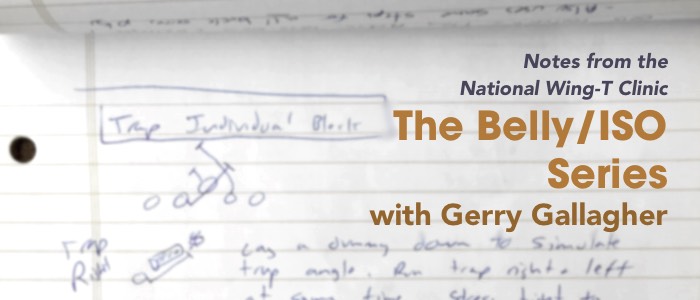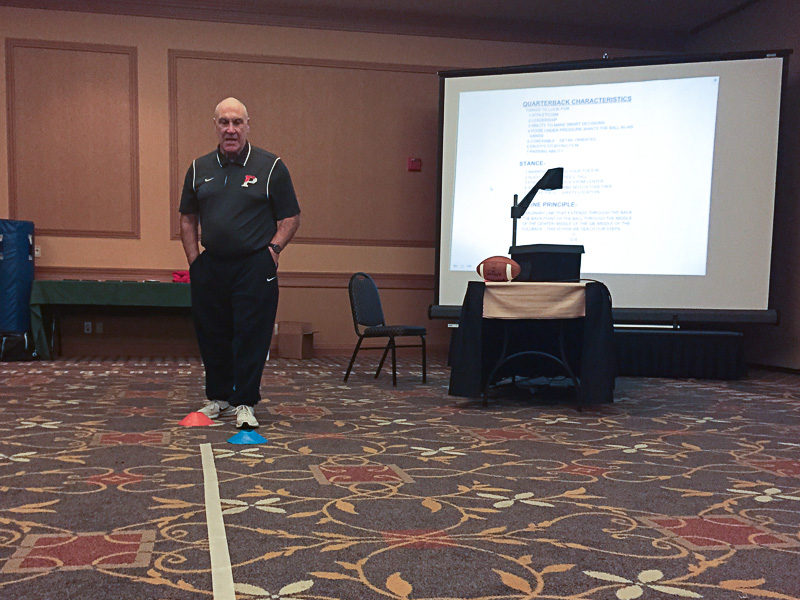The Belly / ISO Series with Gerry Gallagher

Gerry Gallagher closed out the conference with a deep dive into the Belly XB (ISO) play along with the Belly Keep Pass (our ISO Pass). I love Gerry’s DVD Training The Wing-T Quarterback.
Let’s talk some terminology here. My heritage is with the Sherwood High School and Youth football programs, which has its own flavor for the Wing-T. Our “ISO” series is really a sub-category of the classic Delaware Wing-T Belly series. This series revolves around a weak-side (split-end or wide receiver side) isolation play to the fullback. For the past five years we’ve also run the ISO sweep off this play.
The other half of the Belly series is the Down play, which is my favorite play to start with for youth football.
One difference in Gerry’s talk was that he hasn’t really embraced the Belly / ISO sweep so he was very likely to do other things with the back-side wing. For example, if running belly to the left side, he might put the right WB in jet motion to the left and have him kickout 1st free man at the flank.

Why run the belly (ISO) play?
- Hard nosed physical play
- Defense cannot be right
- Great play action pass off of it
- Great counter off of it
- Can be run from multiple formations
- Can vary blocking schemes
- Great goal line play
Gerry stressed that there are two distinct belly paths:
- On the ISO play, it is a deep-rounded path with the handoff happening deep in the backfield
- On the Down play, it is a slash quick hitting play with the hand-off happening just behind the LOS
ISO Play (or 83–87 Cross Block XB)
This is the Wing-T isolation play. Key concepts:
- Deep rounded path by the ball carrier
- Get the ball to the FB DEEP
- Blocking HB and FB have the same initial read (tail of the playside tackle)
- Ball carrier: if your toes stay north and south, your shoulders will stay north and south
- Proper timing and mesh create read conflicts for the defense
- Can combine the blocking scheme with other backfield patterns to create multiplicity (jet and rocket in particular)
Offensive Line Technique for ISO
- Must be able to block ON (we make a line call “BOB”, or big-on-big) when there’s nobody in B gap. Playside tackle should always step first with inside foot and take man where he wants to go. Playside guard vs head up / inside shade, step first with outside foot
- If there’s anyone in B gap, even shading in, use the cross-block technique (we call “Sally”). In the cross block, the playside tackle should use DOWN technique unless there’s a penetrator, in which case use GAP. He has the playside guard hesitate slightly after first pull step.
- For backside players, rule is “fire-on-backer”. If covered, take a fire step, if uncovered take a reach step to playside.
I won’t repeat the backfield footwork here - it is the same as I covered in the Dave McDonald post. When the blocking back is in the wingback position, they have him take a pull step then work to the tail of the tackle.
Belly Keep Pass (ISO Pass)
Their normal route package on ISO pass to the left is to have the LH arrow to the flat. His rule is to aim for the next five yard stripe at the sideline. The RH logs and protects the QB.
The FB will block a LB if he sees blitz, otherwise he runs out to 6 yards and slides to left.
The WR does a 12 yard out, back to 10 yards. If he sees a cover 2, however, he will run a fade where the hit would be at 15 yards.
The TE bends to center at 6 yards then streaks.
The QB does not ride the fake on the Belly pass. His first read is flat coverage - if the defender is backing up, he will quickly hit the arrow route. His next read is to the deep route and if that isn’t there he can run or look for the FB.
Variants on this pass play:
- They will make a “Belly Keep Pass Switch” call which reverses the RH/LH assignment. The playside back will log and protect while the backside back runs the arrow. Obviously this would be done with motion.
- They will run an Belly Keep Pass Curl which has the WR curl at 12 yards.